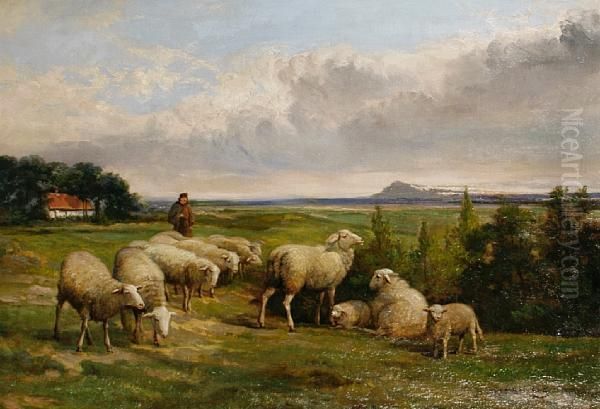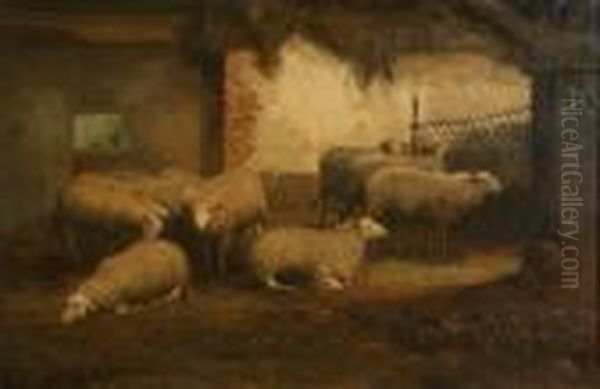Jef Louis Van Leemputten stands as a notable figure in Belgian art history, an artist whose life spanned from 1865 to 1948. Born in Werchter, Belgium, he dedicated his career to the meticulous and heartfelt depiction of the natural world, particularly focusing on animals, landscapes, and scenes of rural life. Operating within the Realist tradition, Van Leemputten developed a distinctive style characterized by careful observation and technical proficiency, earning him recognition both within Belgium and internationally. His work offers a window into the pastoral landscapes and agrarian rhythms of his time, captured with sensitivity and a deep appreciation for his subjects.
Birth and Artistic Lineage
Jef Louis Van Leemputten entered the world in 1865 in the Belgian municipality of Werchter. His artistic inclinations may have been nurtured early on, as he was the son of Jean-Baptiste Van Leemputten. The Van Leemputten name itself carries weight in Belgian art, though it's important to distinguish Jef Louis from other artists bearing the surname, such as Cornelis van Leemputten or Hugo Van Leemputten, who are separate figures often discussed in similar contexts but whose specific histories, according to available records, do not directly intertwine with Jef Louis's primary narrative beyond the shared name. Jef Louis's connection to his father, Jean-Baptiste, suggests a potential familial grounding in the arts, setting the stage for his own path as a painter.
Formation as an Artist: Training and Key Influences
The precise nature of Jef Louis Van Leemputten's artistic training presents a somewhat layered picture based on available accounts. Several sources emphasize his development as a largely self-taught artist. This narrative suggests he received only limited, albeit potentially formative, guidance from his father, who is sometimes referred to as Jan Frans van Leemputten in this context. Following this path, Jef Louis would have honed his skills primarily through intensive, independent study of the natural world. His favoured locales for this immersive research were the landscapes of the Brabant region and the Kempen area near Antwerp, environments rich with the rural motifs that would come to dominate his oeuvre.

However, other records introduce a different dimension to his education, noting him as a student of Charles Verlat (1824-1890). Verlat was a highly significant Belgian painter, known for his historical scenes, animal paintings, and portraits, and a prominent figure in the Antwerp art establishment, including serving as director of the Royal Academy of Fine Arts. If Van Leemputten studied under Verlat, it would have provided him with a more formal academic grounding, potentially influencing his technique and approach, particularly in animal depiction, an area where Verlat excelled.
Regardless of the exact balance between formal tutelage and self-direction, a key external influence on Van Leemputten's style is widely acknowledged: the French artist Charles Jacque (1813-1894). Jacque was a prominent member of the Barbizon School, celebrated for his realistic and often idyllic portrayals of rural life, particularly his paintings and etchings of sheep and farmyard scenes. Van Leemputten's own affinity for depicting sheep and pastoral landscapes strongly echoes Jacque's work, suggesting a clear line of inspiration, whether absorbed directly or through the general artistic currents of the time that carried the Barbizon influence across Europe.
The Realist Vision: Style and Subject Matter
Jef Louis Van Leemputten firmly situated his artistic practice within the Realist movement. His style is characterized by its rigorous commitment to accurate representation, detailed rendering, and a profound respect for the observable world. He avoided overt sentimentality, instead focusing on capturing the textures, light, and atmosphere of the scenes before him with precision and clarity. His brushwork, while descriptive, served the purpose of building believable forms and environments.
His subject matter consistently revolved around the rural and the natural. Animals were a particular forte, with birds and especially sheep featuring prominently in his works. He depicted these creatures not merely as generic types, but often with an attention to individual characteristics and behaviour, suggesting close observation. Whether shown grazing in fields, resting in stables, or being guided by shepherds, his animals possess a tangible presence.
Landscapes provided the essential context for his animal studies and genre scenes. He favoured the gentle, agrarian countryside of his native Belgium, capturing the specific quality of light and the character of the terrain in regions like Brabant and Kempen. His paintings often evoke a sense of tranquility and timelessness associated with pastoral life, depicting farmsteads, country lanes, and open fields under expansive skies. These scenes reflect a deep connection to his homeland and an appreciation for the enduring rhythms of rural existence.
Signature Works and Artistic Achievements

Among Jef Louis Van Leemputten's body of work, certain paintings stand out as particularly representative of his style and thematic concerns. "Shepherd and Flock" , mentioned in records associated with his name, exemplifies his engagement with pastoral themes influenced by artists like Charles Jacque. One can envision a composition likely featuring a shepherd, perhaps weathered and watchful, overseeing a group of meticulously rendered sheep within a specific Belgian landscape setting. Such a work would showcase his skill in animal anatomy, landscape painting, and the creation of a cohesive, naturalistic scene.
Another noted work, "Sheep in the Stable," points to his ability to handle interior scenes and the interplay of light and shadow. This subject allows for a more intimate portrayal of the animals, focusing on the textures of wool, straw, and aged wood, likely illuminated by a directed light source from a doorway or window. It highlights his versatility in depicting animals in varied environments and his attention to atmospheric effects within enclosed spaces. These works, alongside his numerous depictions of birds and other rural motifs, solidify his reputation as a dedicated painter of Belgian country life.
Career Trajectory: Exhibitions and Market Recognition
Jef Louis Van Leemputten achieved a degree of international recognition during his career. Records indicate that his paintings were exhibited not only in Belgium but also across Europe, in the United Kingdom (specifically England), and even in the United States. This geographical reach suggests that his realistic depictions of pastoral life found an appreciative audience beyond his homeland, tapping into a broader taste for landscape and animal painting prevalent in the late 19th and early 20th centuries.
A specific, though perhaps unusually dated, event is mentioned: an exhibition in New York on February 26, 1997, which reportedly featured a painting by him dated 1896. While the 1997 date likely refers to a later sale, auction, or retrospective display rather than an exhibition during his active career, it nonetheless points to the enduring presence of his work in the international art market long after his death.
His paintings continue to appear in the art market, primarily through auctions. Details such as an oil painting measuring 36 x 25 cm being offered for sale confirm the circulation of his work among collectors. Furthermore, an estimated value range of 70,000 to 90,000 RMB (Renminbi) for one of his oil paintings featuring cattle and sheep provides a concrete, albeit specific and regional, indicator of the market valuation and collector interest his work could command in certain contexts. This sustained market activity underscores the lasting appeal of his meticulous Realist style.
Artistic Context, Contemporaries, and Connections
Jef Louis Van Leemputten operated within a rich artistic landscape, both in Belgium and internationally. His Realist approach aligned him with a major current in 19th-century European art, which saw artists turning away from Romanticism and Neoclassicism towards direct observation of the contemporary world. In Belgium, this movement included significant figures like Constantin Meunier (1831-1905), known for his powerful depictions of industrial labourers, and Henri de Braekeleer (1840-1888), celebrated for his intimate interior scenes. While Van Leemputten's focus on rural and animal subjects differed, he shared their commitment to representing the tangible world.
His connection to Charles Verlat, whether as a formal student or simply as a prominent contemporary in Antwerp, places him within the orbit of Belgian academic art circles. Verlat himself was a respected animal painter, potentially reinforcing Van Leemputten's own interest in the genre. The influence of the French Barbizon School, particularly through Charles Jacque, links Van Leemputten to a broader European trend of landscape and rural painting that included masters like Jean-François Millet (1814-1875) and, in terms of the broader Realist impulse, Gustave Courbet (1819-1877).
It is also insightful to consider Van Leemputten's work in the vast historical sweep of art. While he focused on traditional Realism, the art world around him and following him underwent radical transformations. His dedication to pastoral scenes contrasts sharply with the burgeoning modern movements and the diverse artistic expressions of the 20th and 21st centuries. The contemporary art market, where vastly different works command attention and high prices – from the conceptual lightboxes of Douglas Aitken, the psychologically charged narratives of Trenton Doyle Hancock, the iconic Surrealism of Salvador Dalí (1904-1989), the abstract mobiles of Alexander Calder (1898-1976), the immersive installations of Yayoi Kusama (b. 1929), the dreamlike paintings of Marc Chagall (1887-1985), to the socio-political commentary in the art of contemporary Chinese painters like Zhang Xiaogang (b. 1958) – provides a backdrop against which the specific contributions of historical artists like Van Leemputten are viewed and valued. His father, Jean-Baptiste Van Leemputten, and the distinct artistic paths of Cornelis van Leemputten and Hugo Van Leemputten further illustrate the network of artists active during related periods.
Enduring Legacy
Jef Louis Van Leemputten's legacy lies in his dedicated and skillful portrayal of Belgian rural life and the animal world. As a Realist painter, he contributed to the rich tradition of landscape and animal painting in his country, capturing a specific time and place with fidelity and sensitivity. His focus on subjects like sheep and birds, rendered with meticulous detail, offers a lasting testament to his powers of observation and his deep affinity for the natural environment of the Brabant and Kempen regions.
While perhaps not a radical innovator, Van Leemputten mastered his chosen genre, creating works that continue to resonate with viewers who appreciate finely crafted representational art and idyllic depictions of pastoral existence. The continued presence of his paintings in exhibitions and the art market indicates an enduring appreciation for his technical skill and the tranquil, observant quality of his vision. He remains a respected figure among Belgian painters of the late 19th and early 20th centuries who chronicled the enduring beauty of the countryside.
Conclusion
In summary, Jef Louis Van Leemputten (1865-1948) was a significant Belgian Realist painter, renowned for his detailed and atmospheric depictions of animals, particularly birds and sheep, and the rural landscapes of his homeland. Influenced by figures like Charles Jacque and potentially trained by Charles Verlat, while also developing through self-study, he forged a career marked by technical proficiency and a consistent focus on pastoral themes. His works, such as "Shepherd and Flock" and "Sheep in the Stable," exemplify his style. Exhibited internationally and still present in the art market, Van Leemputten's paintings endure as sensitive portrayals of Belgian country life, securing his place within the annals of European Realist art.